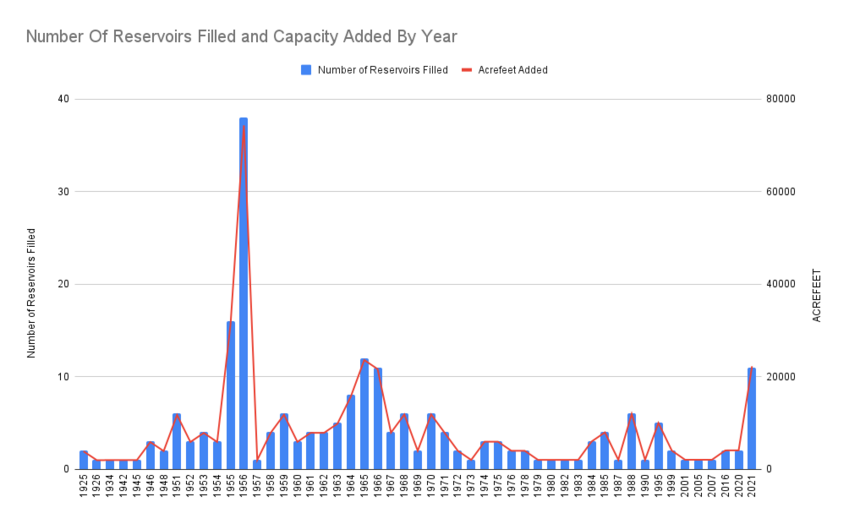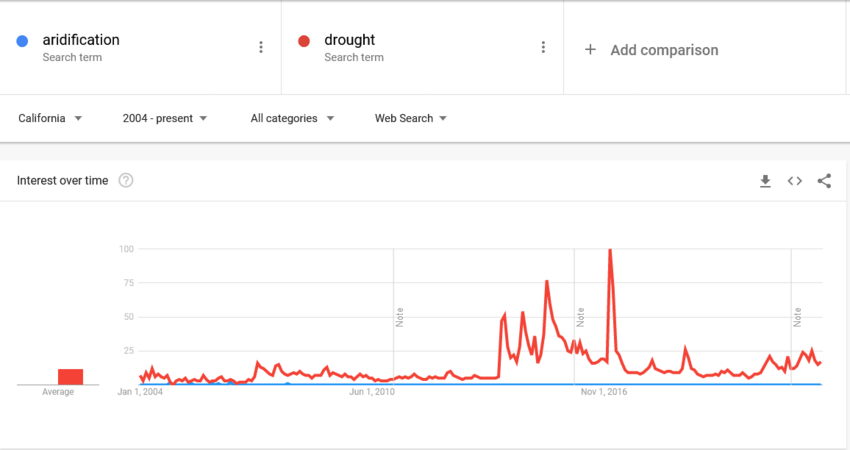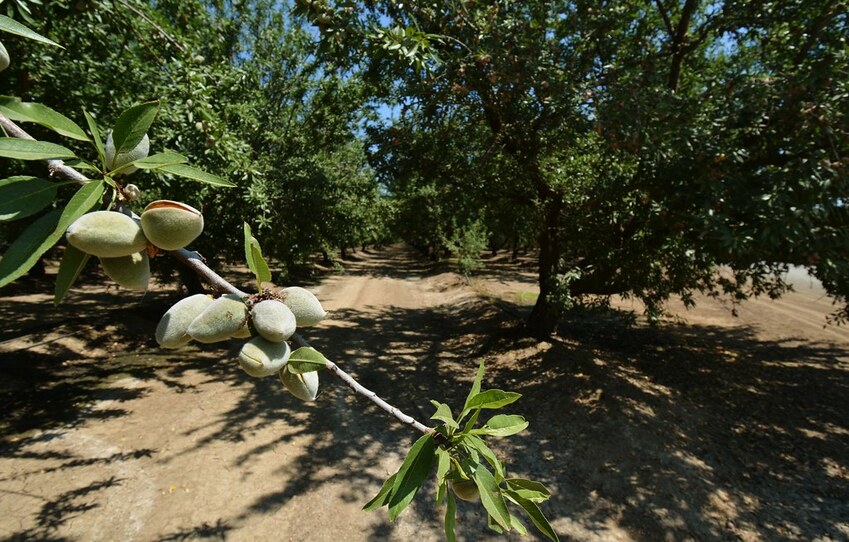This is the third blog post in a series of blog posts on California’s water supply and aridification due to climate change.
1976-77 Drought
Let’s recall Ronald’s message from the second blog post:
Now that the two dry years are past, we must not allow the abundant water supplies of 1978 to lull us into a false sense of security. Droughts do not recur in precise historical sequence or in equal severity. These years 1976 and 1977, together, far exceeded the dryness in our historic prior two-year dry period of record. The experience of the worst earlier drought, covering the seven years from 1928-1934, should be reason enough for Californians not to let up in their water conservation efforts. In the 1928-34 drought, at least one year within the cycle provided near-normal rainfall. The year 1978 may turn out to be a temporary respite, also. Ronald B. Robie, Director of Department of Water Resources for the State of California, 1978
From 1978 to 1990, 20 new reservoirs were filled whose total potential capacity of water was 4,093,162 acrefeet - about an 7% increase in total capacity from 1978’s total reservoir water capacity. California did reasonably well to build capacity. I’m not sure if building more reservoirs is the best solution to address California’s needs today; According to an estimate from the U.S. Geological Survey [8], California used 8,992,979,501,965 gallons of fresh water in 2015 while California’s total reservoir capacity is approximately 19,637,483,990,000 (This scales Lake Mead and Powell’s capacity to California’s water rights percentage of the Colorado River). Clearly the math is not as simple as just having enough capacity here but it does give me confidence that the reservoirs are not the problem with water in California. I think there are other solutions as outlined at the end of Part 4.

The chart above details when California built reservoirs and the amount of acrefootage built. Note in the chart above, it does not list every year from 1925 to 2023. The left axis is the count of reservoirs added that year, and the axis on the right is the capacity of acrefeet added.
Aridification Versus Droughts
The lexicon for how we describe climate change should change. Note in the Google Word Trends pictured below, aridification is woefully underused relatively to drought. Droughts are temporary effects whereas aridification from climate change is a permanent (i.e. in the human timescale) effect to a region. So I ask the reader, is what we are seeing a temporary or permanent effect? I would answer that aridification is the word we should as I believe what we’re seeing is aridification due to climate change.

Perhaps the over-utilization of droughts is problematic to the public’s perception of climate change. Most people in the western world have not been impacted in any significant way when they’ve experienced a drought due to an abundance of water supply. Most population centers on the planet is experiencing aridification en masse simultaneously and perhaps misidentifying aridification as drought. The public may expect the same outcome as any other drought they have encountered before; but instead - like as I described in the previous post - the public could face a very bleak outcome if the water infrastructure isn’t resilient enough. It might look like ghost towns or ghost metropilii.
You might ask, “Clinton, are you serious about that extremely dire situation of ghost towns?” Yes! Droughts come and go. It’s extremely unusual for a drought to cause people to relocate from their metropolis (I’m not saying it doesn’t happen. It does). With aridification permanence, you have to consider that the water reservoir levels cannot be reliably be restored to what we’re familiar with. The reservoirs will not fill as high.
Aridification is something California and other parts of the world should become resilient to. The design of our water infrastructure should be designed toward this scenario this century.
What Policies Could Help Mitigate the Worst of Aridification?
The most immediate way to address this would be to improve the water usage in agriculture. There isn’t one exact method that will improve this but a set of methods and measures.
One straightforward but potentially costly thing to do is to limit field flooding which is a method to water a field of crops and/or prepare a field for sowing (yes, sometimes this is perfectly fine when there is heavy rainfall; but we stand to do better with when we do this). Irrigation systems that lie either on the surface or subsurface can be ways to help target watering to the roots of crops but require a great deal of investment and are not a universal solution for all crops.
I’ll cover two more ideas here: GMO crops that reduce water usage and water reclamation. Covering other water conservation strategies for California’s agriculture sector, the Central Valley, and Imperial Valley are beyond the scope of this set of blog posts on the water reservoirs of California. It merits its own set of blog posts for which ought to cover at the very least:
- Ground Water
- Subsidence
- JG Boswell
- Tulare Lake
- Kern Water Bank
- Flood Irrigation Alternatives
- Fallowing Fields
- Lake Mead
Water Use Efficient GMO Plants
Agriculture is responsible for 40% of California’s water use [3]. If genetically modified plants need less water, this could help save a great deal of water. Let’s illustrate this point on two crops that are notoriously thirsty for water: alfalfa and almonds (disclaimer: this is just to illustrate the point and not in any way realistic here) under the following hypothetical scenario:
- Let’s assume we can make our GMO’d alfalfa and almonds use 25% less water. That does sound like a lot but let’s be ambitious and we’ve been able to produce a tobacco crop that is 25% more efficient [4].
- The fine folks at UC Davis’ Agricultural and Resource Economics have a cost studies site that reviews costs to growing crops in various regions in California. It’s fascinating to learn that for the same crop, the amount of water needed can vary by region and methodology for growing. We’ll use one number that’s within the cost studies for almonds and alfalfa.
- Lastly we’ll use the California Agricultural Production Statistics [1] to get some idea of how much land is used across California to grow almonds and alfalfa.
- We’ll ignore the water used to establish an orchard of almonds or a field of alfalfa. We’ll only focus on the water used to produce almonds and alfalfa for a harvest.
GMO Alfalfa Scenario

- For 2021, 515,000 acres of almond trees were harvested.
- Using the cost studies, we can assume 42 acre-inches (3.5 acrefeet) per acre for a harvest. Note that the cost studies indicate that watering can vary greatly from as little as 18 acre inches to even over 60 acre-inches depending on the region that it is grown.
In total, this scenario shows 1,802,500 acrefeet of water used in California to grow alfalfa. With GMO alfalfa that allows 25% less water use, we’d save 450,625 acrefeet of water.
From the water conservation perspective there is some good news! From the 2021 California Agricultural Production Statistics [1], we’ve nearly halved the acreage which translates to a tremendous amount of water conserved.
GMO Almond Scenario

- For 2021, 1,250,000 acres of almond trees were harvested.
- Using the cost studies, we can assume 42 acre-inches (3.5 acrefeet) per acre for a harvest.
In total, this scenario shows 4,375,000 acrefeet of water used in California to grow almonds. You could fill the largest water reservoir within California, Lake Shasta, with that much water! If we grew GMO almonds that allowed 25% less water use, that would translate to a savings of 1,093,750 acrefeet of water a year. That’s a sizable amount of water!
How realistic of a solution is GMO to water conservation?
Annual crops like alfalfa make sense. They’re quick to grow and can have a great change right away. I think this is something that should be an area of investment that California and the world can benefit from just from a food security perspective alone.
Almonds are a different story as they come from trees and that may take quite some time to realize a GMO almond worthwhile using; then more time getting an orchard to replace their existing trees which could be productive for up to 25 years or more. GMO almonds are not realistic at all but used merely as demonstration from a water thirsty crop.
Improved Water Reclamation in California
I will write about this in Part 4 for stormwater and wastewater recycling. The amount of water we’re talking about is a paltry sum relative to what agriculture consumes but can help serve the large metro areas of california quite well. It turns out the urban areas of California don’t use that much water relative to the agriculture sector.
Check Out Part 4
Check out Part 4 of this blog series on California Water Reservoirs!
References
- https://www.cdfa.ca.gov/Statistics/PDFs/2021_Ag_Stats_Review.pdf
- https://blog.ucsusa.org/marcia-delonge/in-californias-central-valley-drought-is-a-growing-threat-to-farms-food-and-people/
- https://www.ppic.org/publication/water-use-in-californias-agriculture/
- https://www.nature.com/articles/s41467-018-03231-x
- https://www.flickr.com/photos/slvnative/1416025940/
- https://live.staticflickr.com/4413/35701112313_d599e43d49_b.jpg
- https://coststudies.ucdavis.edu/en/current/
- https://pubs.er.usgs.gov/publication/cir1441